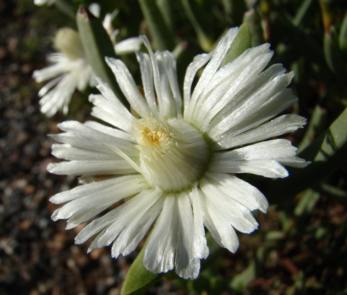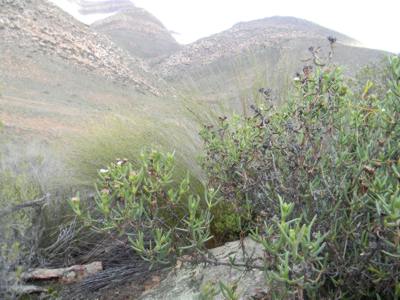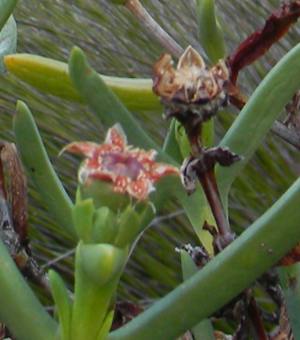Stayneria neilii
Stayneria neilii (L.Bolus) L.Bolus
Family: Aizoaceae
Common names: white-flowered mesemb (Eng.); witblomvygie (Afr.)
Introduction
Scarce in cultivation, this attractive water-wise succulent shrub is not well known in horticulture but is ideal for arid gardens in the winter-rainfall region.

Description
Description
Stayneria neilii is a stout woody shrub of up to 1.5 m in height, bearing reddish brown stems with persistent hardened remains of old leaves. The stem-clasping leaves are dark green, three-sided with a sharp bottom edge and smell like berries. Fragrant leaves in the Aizoaceae family are uncommon and therefore this is an almost unique characteristic rarely found in other genera. Small daisy-like white to pink flowers are arranged in terminal groups of three to seven and borne during the winter and early spring (July to September in the southern hemisphere).

The fruit are large capsules up to 20 mm across, containing pear-shaped seeds that are brown in colour.
Conservation Status
Status
Stayneria neilii is listed as Vulnerable on the Red Data List due to habitat loss caused by the expansion of vineyards.
Distribution and habitat
Distribution description
This species is endemic to the Breede River Valley, in the Western Cape, from Worcester to McGregor. It grows in Succulent Karoo on acid, quartzitic sandstone soil among rocks in high shrubby vegetation where it is inconspicuous in spite of its height. Rainfall occurs mainly in winter and varies from 200-300 mm per year.

Derivation of name and historical aspects
History
Stayneria was named in honour of Mr W.F. Stayner (1907-1981), a previous curator of the Karoo National Botanical Garden at Worcester from 1959-1969. The specific epithet neilii is named for the 20th century South African dairy farmer and nurseryman Mr Neil. The genus Stayneria is monotypic (it contains only one species).
Ecology
Ecology
The flowers open during the day and are pollinated mainly by insects such as beetles, bees and wasps.
Fruit capsules have valves which open when wet to disperse the seeds at short distances from the parent plant, and once opened the capsule remains open. This is also an almost unique feature with Stayneria neilii , as most members of the Aizoaceae have fruit capsules that open in the presence, and close in the absence of water.

Uses
Use
This plant has horticultural potential and should be introduced as a garden subject for its drought tolerance, unusual leaf texture and size, and attractive flowers that appear during winter and spring.
Other than its gardening potential, no other uses have been recorded.
Growing Stayneria neilii
Grow
Stayneria neilii is best suited for well-drained rockeries in combination with Aloe microstigma , the speckled Worcester Aloe, the showy Drosanthemum speciosum with its masses of red flowers , the handsome cushion-like Cylindrophyllum tugwelliae with their solitary large white flowers and Cotyledon orbiculata with yellow flowers. Plants are easily propagated from seeds or cuttings but seeds are preferred as they produce better genetic variability. Seeds can be sown in autumn in a sandy loam soil. Keep the seeds moist by misting. Plants will only start to flower when they reach a height of about 70 cm. Cuttings can be taken in autumn, and no rooting hormone powder is necessary. Cuttings are planted in well-drained coarse river sand. The genus is prone to attack by white scale insects and red spider mite. (S. Hammer, pers. comm. 2013).
It is important to keep the plants dry in summer as this will reduce the chance of fungal or white scale infestation.
References
- Hartmann, H.E.K. 2001. Illustrated handbook of succulent plants: Aizoaceae F-Z . Springer-erlag Berlin, Heidelberg, Germany.
- Jackson, W.P.U. 1990. Origins and meanings of names of South African plant genera . U.C.T. Printing Department, Cape Town.
- Smith, G.F., Chesselet, P., Van Jaarsveld, E.J., Hartmann, H., Hammer, S., Van Wyk, B-E., Burgoyne, P., Klak, C. & Hubert, K. 1998. Mesembs of the world. National Botanical Institute, Pretoria.
Credits
Shireen Harris
Karoo Desert NBG
February 2013
Plant Attributes:
Plant Type: Perennial, Succulent
SA Distribution: Western Cape
Soil type: Sandy, Clay, Loam
Flowering season: Spring, Winter
PH: Acid
Flower colour: White
Aspect: Full Sun
Gardening skill: Average
Special Features:
Horticultural zones







Rate this article
Article well written and informative
Rate this plant
Is this an interesting plant?
Login to add your Comment
Back to topNot registered yet? Click here to register.